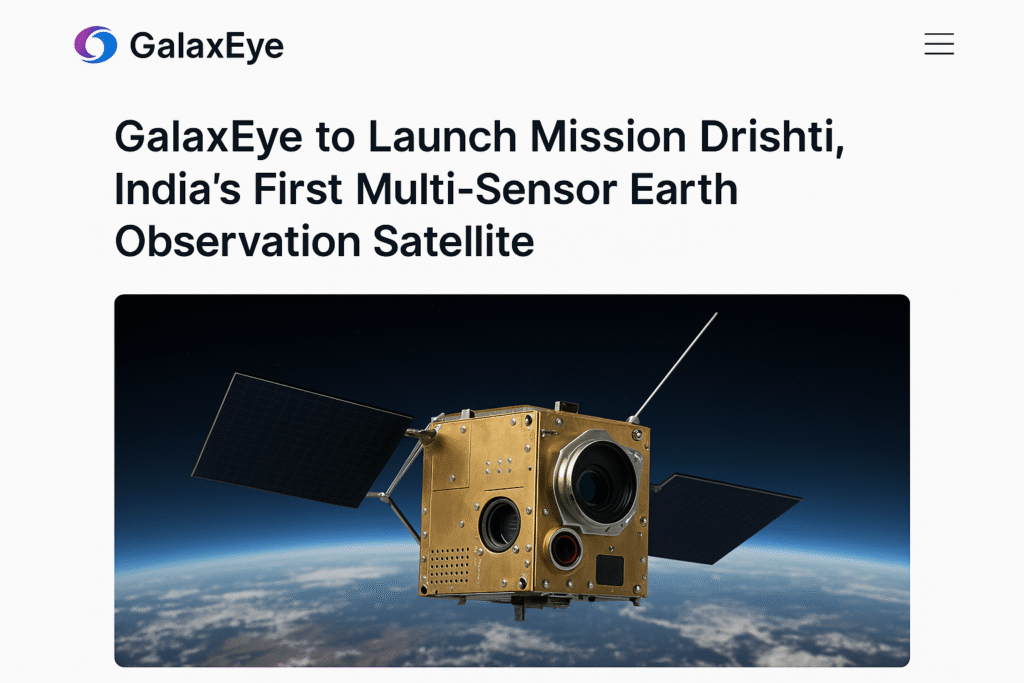By Harshit | 13 October 2025 | Bengaluru | 10:00 AM IST
GalaxEye Announces Mission Drishti Launch
Indian space-tech startup GalaxEye has revealed plans to launch Mission Drishti, the world’s first multi-sensor Earth observation (EO) satellite, in the first quarter of 2026. The announcement marks the start of a constellation of satellites the company aims to deploy over the next four years, setting the stage for high-resolution geospatial monitoring capabilities from space.
The mission was unveiled on Monday, October 13, 2025, and signals a significant step for India’s private space sector. Mission Drishti is India’s largest privately built satellite and also the country’s highest-resolution EO satellite, offering 1.5-metre resolution imagery.
Advanced Capabilities and Applications
Mission Drishti combines multiple sensing technologies on a single platform, including synthetic aperture radar (SAR) and high-resolution optical payloads. This integration allows the satellite to capture high-precision data regardless of weather conditions or time of day, giving users continuous monitoring capability.
According to Suyash Singh, co-founder and CEO of GalaxEye, “With Mission Drishti, we are unlocking a new era of actionable data through space exploration. For the first time in the world, we are deploying a satellite that combines multiple sensing technologies on a single platform, enabling us to observe the Earth in ways that were previously impossible.”
The satellite will serve multiple sectors, including:
- Government and Defence: Border surveillance, defence monitoring, and strategic intelligence.
- Disaster Management: Real-time monitoring of floods, cyclones, and other natural disasters.
- Utilities and Infrastructure: Assessment of energy grids, transport networks, and urban development.
- Agriculture: Crop monitoring, precision farming, and soil health analysis.
- Financial and Insurance: Risk assessment for infrastructure projects, crop insurance, and asset verification.
Technical Details
Mission Drishti weighs 160 kg and has been tested for extreme conditions, including structural integrity under high and low temperatures, to ensure reliability in the harsh environment of space.
The satellite’s remote-sensing system is engineered for optimal spatial, spectral, and temporal resolutions, allowing precise capture of images and data for analytical purposes. The company has emphasized that each satellite in the upcoming constellation will be designed with similar capabilities, gradually building a network capable of continuous, high-resolution Earth monitoring.
Plans for Satellite Constellation
GalaxEye plans to launch 8–10 satellites over the next four years, establishing a comprehensive constellation capable of delivering frequent, high-resolution updates for a wide array of commercial, industrial, and governmental applications.
“This mission places India firmly on the global space map and creates a system that turns space technology into intelligence that businesses, governments, and communities can rely on,” Singh said.
The constellation will allow continuous monitoring of strategic locations, improving real-time decision-making for industries and government bodies. By integrating multiple sensors on each satellite, GalaxEye expects to provide a level of Earth observation precision and flexibility not yet seen in commercially available systems.
Global and National Significance
Mission Drishti represents a major milestone in India’s growing private space industry, highlighting the country’s capabilities in building high-resolution satellites independently. It underscores the potential for private companies to complement government-led initiatives like ISRO’s satellite programs, while also opening up new revenue streams through data-as-a-service for commercial clients globally.
Experts note that multi-sensor satellites, combining optical and radar imaging, have the advantage of all-weather, day-and-night operation, which is crucial for defence, agriculture, and disaster management. With Mission Drishti, India becomes a key player in providing actionable Earth observation data at a scale previously dominated by international corporations and space agencies.
Looking Ahead
The launch of Mission Drishti is scheduled for early 2026, and the subsequent deployment of the satellite constellation over the next four years will transform Earth observation services in India. By leveraging advanced multi-sensor technology, GalaxEye aims to provide governments, industries, and research organizations with reliable, high-resolution geospatial intelligence that supports informed decision-making.







